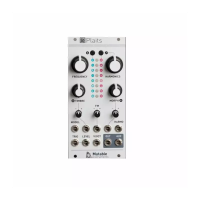modif. 1|in1 lfo1|in2 lfo2|oper prod
In the example above, the modulation source
is defined as the product of
following operations are available:
adds the values of the two modulation sources.
computes the product of the two modulation sources.
computes the product of a bipolar version of the first source, and the second source.
takes the maximum of the two sources.
takes the minimum of the two sources.
outputs a large value if source 1 is above soure 2, 0 otherwise.
outputs a large value if source 1 is below soure 2, 0 otherwise.
outputs the value of in1 quantized into a number of levels defined by in2. For example, if you set a
constant value (say = 4) as in2, the modulation source in1 will be quantized into 4 discrete steps, as if
it was processed through a bit-reducer! This is useful for creating pseudo S&H effects.
outputs the value of in1 filtered by a lowpass filter whose cutoff frequency is set by in2. For
example, if you use a constant value (say = 4) as in2, the modulation source in1 will be strongly
low-pass filtered. This is very useful for smoothing a square or S&H lfo!
Volu 120|mode poly|lega off|port 0
octv 0|tune 0|sprd 0|raga equa
: Part volume. Note that the volume attenuation is done by scaling the value of the
control signal – causing a potential loss of resolution in the shape of the
: Polyphony handling. When this is set to
, all voices assigned to this part are
simultaneously played in unison, and you cannot play chords (only the most recently played note is
heard). When this is set to
, the notes you play are dispatched to the voicecards. Obviously, the
Ambika – User manual | Mutable Instruments http://mutable-instruments.net/ambika/manual
26 of 44 2/17/17 4:58 PM

